Richard Feynman's famous talk on atom-by-atom assembly is often credited with kick-starting nanotechnology. Fifty years on, Philip Ball investigates how influential it really was
Richard Feynman’s famous talk on atom-by-atom assembly is often credited with kick-starting nanotechnology. Fifty years on, Philip Ball investigates how influential it really was
Fifty years ago, the near-legendary physicist Richard Feynman of the California Institute of Technology (Caltech) gave a talk called There’s plenty of room at the bottom to the American Physical Society’s West Coast section. He outlined a vision of what would later be called nanotechnology, imagining ‘that we could arrange atoms one by one, just as we want them’. The rest is history.
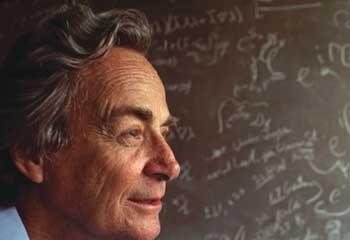
But what sort of history? Did Feynman’s talk, published the following year in Caltech’s house magazine Engineering and science, really kick-start nanotechnology, or is that just a convenient fiction to link this emerging field to a colourful visionary?
There are three ways of approaching this question. One is to look at what Feynman said and ask how it relates to what nanotech is now about. Another is to see what effect his talk actually had on the science and engineering of his time. And the third is to ask researchers now actively engaged in nanotechnology whether Feynman’s talk holds any inspiration or insight for them.
All three lines of inquiry point to a rather different story from the one generally told. Feynman’s talk didn’t in any sense start nanotechnology. It didn’t really stimulate any new research at all, although the miniaturisation challenges he set sparked some neat feats of engineering. Indeed, some of Feynman’s contemporaries even wondered if his intent was purely comic (which would have been very much in character). Very little of the later, foundational work in nanotech drew on Feynman’s vision, and most was conducted in complete ignorance of it. His talk can be seen in some respects as equivalent to the ’prophetic’ writings of mediaeval scholars such as Roger Bacon and Nostradamus: flights of fancy that later ages have combed for ’evidence’ of foresight, with their predictions of submarines, telephones and so on.
And yet such a revisionist take doesn’t quite do justice to the matter. There is something in Feynman’s Plenty of room that rings true, that reveals a fantastically creative mind imagining what might be possible and what we might do with it. Most of all, Feynman can lay claim to a real intellectual legacy, for he asked, as nanotechnologists do, what might be achieved by manipulating matter on a truly tiny scale. Fifty years on, some of Feynman’s words sound inevitably dated, but others remain deeply pertinent. While it might be wise to stop pretending that his address to the APS was the ‘birth of nanotechnology,’ that needn’t prevent us from relishing the spectacle of a genius giving free rein to his imagination. It was, according to George Whitesides of Harvard University, US, ‘yet more validation, if any were needed, of Feynman’s perceptiveness and openness to new ideas’.
Sacred text
It is hard not to be impressed at the prescience of much of what Feynman had to say. ‘People tell me about miniaturisation, and how far it has progressed today,’ he said. ‘There is a device on the market, they tell me, by which you can write the Lord’s Prayer on the head of a pin. But that’s nothing . Why can we not write the entire 24 volumes of the Encyclopaedia Britannica on the head of a pin?’
He estimated that this might involve making dots 32 atoms across to create the dot matrices for the half-tone photos in the encyclopaedia. How do you write that small? he asked. He predicted that the answer might involve rearranging individual atoms. ’Feynman did in a visionary way predict atomic-scale nanofabrication,’ says Cees Dekker of the Technical University of Delft in the Netherlands, who has conducted seminal work on carbon nanotube electronics.
That vision was famously realised in 1990, when Don Eigler and Erhard Schweizer of IBM’s Almaden research centre in San Jose, California, US, wrote their company’s name using the scanning tunnelling microscope (STM) to manipulate individual xenon atoms. These were adsorbed on the surface of nickel, creating letters five atoms high and achieving a data storage density over 100 times greater than Feynman’s conservative estimate for what might be needed to write with atoms.
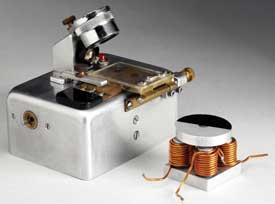
Indeed, one could say that Feynman didn’t think small enough. He ended by offering two $1000 prizes (big money in 1959): one to ‘the first guy who can take the information on the page of a book and put it on an area 1/25 000 smaller in linear scale,’ the other to ’the first guy who makes an operating electric motor which can be controlled from the outside and . is only 1/64 inch cube’. The latter challenge was far too easy, or rather, it underestimated the dexterity of engineers: just months later, William McLellan of Caltech claimed the prize with a device made by hand, which now sits in a niche in the corridors of Caltech (its coils burnt out long ago). In fact, McLellan made 10 of them, with crude tools including toothpicks and paint brushes. ’He really didn’t believe it could be done,’ McLellan says. ‘But he found out.’
The book challenge took rather longer - it was met in 1985, three years before Feynman’s death from cancer, by Tom Newman, a graduate student at Stanford University, US, using electron-beam lithography. (He took his text from Dickens.) Now there are cheaper ways to write even smaller: Chad Mirkin of Northwestern University in Evanston, Illinois, US, has used dip-pen nanolithography, where the tip of an atomic force microscope is used as a nib to write with a molecular ink that might then serve as a mask in chemical etching of the surface, to inscribe some of the very text quoted above from Feynman’s talk, in letters about 60 nanometres across.
But one of the most significant aspects of Feynman’s text is its focus on information. It was already becoming clear in 1959, a year after the invention of the integrated circuit, that miniaturisation would be important in computer technology. ‘Work on the transistor had been miniaturising and miniaturising since its invention in 1947,’ says chemist Mark Ratner, also at Northwestern and author of Nanotechnology. ’Whether the physics community thought in those terms isn’t so clear, but Feynman was certainly aware of what the engineers’ thoughts were.’ All the same, this was six years before Gordon Moore of Intel coined his renowned ‘law’ describing the shrinking of computer circuit elements, and there was none of the now commonplace presumption that data storage and processing would have to happen at an ever-decreasing scale. Yet Feynman proclaimed that, with a capacity for atom-craft, ‘all of the information that man has carefully accumulated in all the books in the world can be written in a cube of material one two-hundredth of an inch wide.’
What’s more, he recognised how much of this facility for manipulating matter and storing information at the nanoscale was already apparent in biological systems. In DNA, he said, ‘approximately 50 atoms are used for one bit of information about the cell’. And biology ‘is not simply writing information; it is doing something about it’. Today, molecular and cell biology are frequently cited not only as an ‘existence proof’ that nanotechnology is possible but as a rich store of ideas for how it might be achieved. But in 1959, says Dekker, ’people simply were not thinking about biological structures in terms of machines’. That Feynman did so only six years after the discovery of the information-encoding structure of DNA was remarkable. ’If I look at the two biggest technological revolutions in the past half century, I would mention information technology and the molecular biology revolution,’ says Dekker. ‘Feynman mentioned both.’
Where Feynman scores less strongly is on the role of chemistry in nanoscale engineering. ‘He spent a lot of time thinking about computation and computers, but not much time thinking about molecules and the way they organise space and matter,’ says Ratner. ‘My guess is that if you presented him with a five-coordinate carbon atom, it wouldn’t have bothered him any more than a four-coordinate carbon atom would have. The soft-matter world was not his forte.’
Most crucially, he seems not to have appreciated (in fairness, neither did anyone else at the time) that nature’s prowess in nanotechnology relies heavily on the propensity of chemical systems to self-assemble. ‘I think that is the most important thing missing in the talk,’ says Ratner. ’He talked about making things, but the making didn’t seem to involve self-assembly, but rather carving.’
‘To my reading, Feynman gave the impression that chemistry was a distant discipline, whilst conceding that chemists could make anything,’ says Fraser Stoddart, now also at Northwestern University in Illinois, who has pioneered self-assembly of complex molecular structures. ‘This claim on behalf of the synthetic chemists of the late 1950s was simplistic, bordering on na?ve.’
’He assumed that the science of small things would be dominated by physics,’ says Whitesides. ‘As it turns out, the engineering of small things has been dominated by electrical engineering and materials science, and by chemistry and molecular biology. So I would say that he got the "vector" entirely right, and the details entirely wrong.’
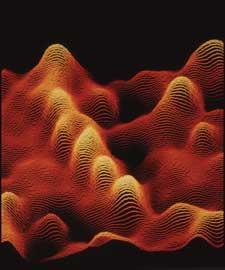
It’s sometimes said that, having aired his wild thoughts on atomic-scale engineering, Feynman never again returned to the subject. But he did. In 1983 he reconsidered his ideas in a talk at the Jet Propulsion Laboratory in California, entitled ‘Infinitesimal machinery,’ which too found its way into print. (A video of the talk also exists, showing that the written texts of Feynman’s talks present a sanitised version of his freewheeling, often zany method of verbal delivery.) Three things stand out. First, it’s notable that many people don’t even know about this epilogue to Plenty of room - for sacred founding texts do not need (are perhaps even marred by) sequels. Second, Feynman confessed in the later talk that ’there has been no progress’ in figuring out what to do with tiny machines. ‘I’m fascinated and I don’t know why,’ he said, before admitting that ’I know there’s already been a lot of laughter in the audience - just save it for the uses that I’m going to suggest for some of these devices, okay?’ Here, perhaps, he was still limited by the preoccupations of his times. ‘He was thinking in the Sputnik era,’ says Stoddart. ‘Health, energy and the environment were not on his radar screen.’
Third, the talk supplied the same mixture of sheer speculation and acute prescience that Plenty of room evinced. He anticipated sacrificial-layer microfabrication, where thin films of material are deposited and then evaporated to separate moving parts in silicon micromotors. He talked about the problem of ‘stiction’ - the adhesion of nanoscale moving parts because of molecular-scale attractive forces - which is now recognised as problematic for tiny machinery. And he mentioned ’a machine that computes and works by quantum-mechanical laws of physics’ - a quantum computer.
Any takers?
For all its strengths and weaknesses, did anyone actually listen to Feynman’s ideas? ‘Feynman was Feynman,’ says Ratner, ‘and a lot of people would listen to him who might not be willing to listen to people of lesser reputation, in part because he put things so beautifully.’ Yet if they listened, it’s not clear that they were inspired to act. In a myth-busting article of 2005 published, cheekily, also in Engineering and science , anthropologist Chris Toumey of the University of South Carolina dissected the real ‘influence’ of Feynman’s talk. How many citations did Plenty of room generate, Toumey asked? Until 1980, you could count them on your fingers: three in the 1960s, four in the 1970s. And one of these, a survey of advances in information technology in 1969, called Feynman’s speculations about storing information in single atoms ‘completely vacuous as far as the real world is concerned’.
Even if that last remark chalks up a point for Feynman, the evidence therefore suggests that his ideas were at first almost totally ignored. Then, from around 1980 until 2002, the growth in citations increased exponentially. What made the difference?
Two things, Toumey suspects. One was that the science caught up. The STM and its ilk were invented during the early 1980s by Gerd Binnig of IBM’s research laboratories in Zürich and his collaborators, Heinrich Rohrer and Christoph Gerber at IBM and Calvin Quate at Stanford University in California. Eigler says that ’Feynman’s work would be on a dusty shelf without Binnig. It was Binnig who blew life into nano by creating the machine that fired our imaginations’.
Yet the inventors of these devices didn’t even know what Feynman had said. ‘Binnig and I neither heard of Feynman’s paper until scanning tunnelling microscopy was widely accepted in the scientific community, nor did any of our papers ever refer to it,’ says Rohrer. Quate denies prior knowledge of it, and Binnig told Toumey that even then he hadn’t read it.
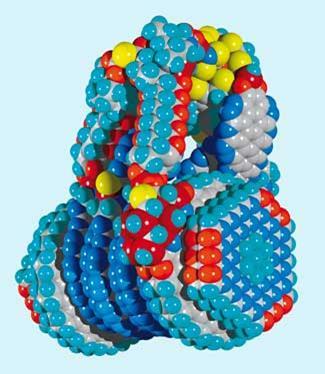
The other reason for the rising fame of Feynman’s talk was more controversial. In 1981 engineer K Eric Drexler published a paper entitled Molecular engineering: an approach to the development of general capabilities for molecular manipulation. It cited Feynman in the very first sentence, and went on to outline a vision of ‘microtechnology’ at the molecular scale that Drexler later developed in his 1986 book Engines of creation , which became the point of entry to nanotechnology for many lay readers.
Drexler’s vision aligned itself very much with what Feynman seemed to be saying. Where Feynman said ‘it would be interesting in surgery if you could swallow the surgeon. You put the mechanical surgeon inside the blood vessel and it goes into the heart and "looks" around,’ Drexler conjured up images of nanoscale robots patrolling the bloodstream for blockages or invaders. Most crucially, Feynman imagined a rather literal scaling down of macroscopic mechanical engineering in order to make ‘a billion tiny factories, models of each other, which are manufacturing simultaneously, drilling holes, stamping parts, and so on’. Drexler seized on this idea, elaborating in his subsequent, more technical book Nanosystems (1992) on the notion of nanoscale cogs and levers made of diamond-like carbon and coated where necessary with lubricating molecular films. Most notoriously, Drexler considered the notion of giving these nano-machines the capability to build copies of themselves - to replicate - precipitating the storm-in-a-teacup of nanotechnological grey goo that devours the world.
Drexler’s blueprint for nanotechnology has been criticised extensively, most famously by an acerbic exchange with the late Richard Smalley of Rice University, a discoverer of nano’s poster molecule C60. Much of this criticism centres on Drexler’s mechanistic literalism and its apparent neglect of chemical principles, which restrict what is possible by mechanical means but also offer smarter ways of achieving similar goals. That, however, isn’t the point here. Even Drexler’s critics cannot deny that he was hugely influential to the public visibility of nanotechnology in its early days, boosted by Drexler’s founding of the Foresight Institute in Palo Alto, California, to promote the topic generally and Drexler’s ‘molecular machinery’ version of it in particular. And at every juncture, Drexler took the opportunity to promote Feynman’s talk as the foundational text of the subject, perhaps because it meshed so well with his own vision.
This may lead some chemists to be sceptical of Feynman’s insights. Jim Gimzewski, a specialist in STM nano-manipulation at the University of California at Los Angeles, US, dismisses many of them as ’the basis of Drexler’s mechanistic Newtonian models’ of nanotech. ‘Neither Feynman nor Drexler appreciated the ability of chemical synthesis to respond to the nanotechnological age,’ says Fraser Stoddart. ’Both saw it as a given in the same billiard-ball type mode that had met the needs of the dye-stuffs and pharmaceutical industries.’
In retrospect
Whether or not the true founders of the science of nanotechnology knew of Feynman’s talk at the time, no one who enters this field can be ignorant of it now. What do they make of it? Is it a source of inspiration, a curiosity, or an irrelevance?
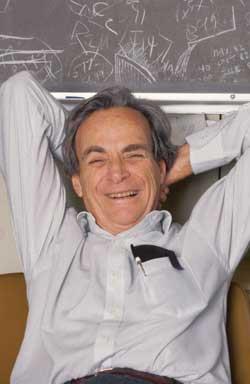
‘I had read it a long time before first manipulating atoms with the STM,’ says Eigler. ‘Within weeks of [doing that work], I went back to dig up Feynman’s paper. I was more than ever impressed with how prescient Feynman’s thought were.’
‘I am not so inspired by the talk’s content,’ says Gimzewski, ‘but more by the fact that he did speculate and was not the typical academic. He had character and was a bit crazy.’ Whether any of these speculations hit the mark is not really the point, he says. ‘He threw a bunch of darts, and some accidentally landed on where the future was going. He carpet-bombed the future.’
Whitesides believes that, for most researchers, an interest in what Feynman says comes post hoc: ‘My sense is that most people in nano become excited about it for their own reasons, and then lean on Feynman as part of their justification for their interest. Most scientists require "permission" to work in new areas, and Feynman provided that.’ For his own part, Whitesides says that Feynman’s talk ‘had no influence on what we have done. ‘Late on, I have read parts of it, but only parts. It has never seemed that relevant’.
‘Feynman had a dream, but he did not come up with a blueprint,’ says Stoddart. ‘Yet it would have been asking a lot of him to see much beyond what he did see and predict. He did not recognise the power of chemistry to drive nanotechnology in a meaningful way. He did, however, help to stimulate a number of chemists to start thinking about meaningful ways to do bottom-up manufacturing.’
Perhaps in the end the inspiration Feynman offers comes not from what he said, but from the fact that he said it at all. ‘In a world in which atoms and molecules and small structures were "not physics" and not fashionable,’ says Whitesides, ‘Feynman said "Oh yes they are and there is lots to do there!’" That took great imagination, says Ratner. ‘Bold speculative visions are wonderful, and imagination is crucial to the development and introduction of new scientific ideas. And imagination was Feynman’s great stock in trade.’
Further Reading
An article in Popular Science (November 1960), condensed from a speech addressed to the annual meeting of the American Physical Society meeting on 29 December 195 at the California Institute of Technology (Caltech). The full transcript of the speech appeared in the February 1960 issue of Engineering and Science Magazine, published by Caltech; the full transcript cam be viewed on the web with their kind permission.






No comments yet